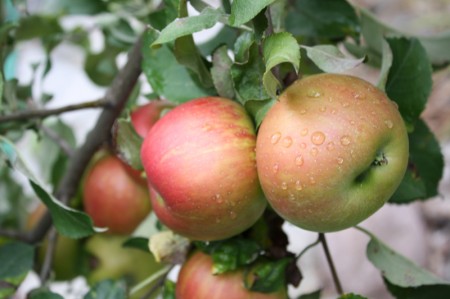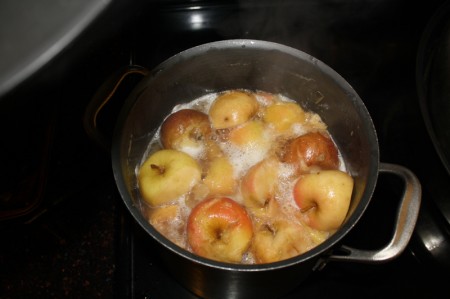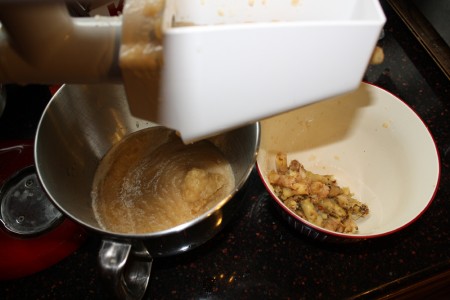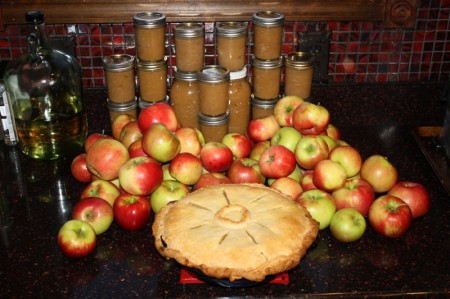Harvesting Apples and Making Apple Sauce
September 29th, 2013This is prime time for apple harvesting, the earliest varieties would have been ready in August, the majority in September, and even then some into October, and the latest in November. I was really excited this year to get the first good apple harvest from my apple trees. They should have been big enough to produce last year, but an inopportune cold snap decimated my apple trees in the spring, getting down to below 20 when the flowers had just opened, the entire state of Michigan lost something like 98% of the apple harvest.
I have a mere two producing apple trees, a honeycrisp, which I’ve since harvested, and a yellow delicious, which I will harvest next week. If I had to recommend only one tree, I would recommend the honeycrisp, it is an excellent apple, produces well, and is good is pretty much all apple applications from pies to cider. But I tell you what, even 1 semidwarf apple tree can produce a lot of apples. Even without spraying any chemicals, even with squirrels and whatever else stealing a few, you’ll get a lot of apples. So what do you do?

The first important issue when harvesting apples is deciding when. You need to know what apple type you have, and then you can use the Internet to figure out when it ripens in your area. Commercial growers will actually pull apples and test them for sugar content, you can try taste testing or just go by historic averages. Of course, if you don’t know the variety you have, you’ll have to do taste testing. Color is not a reliable indicator of ripeness, many apples will change color long after they’re ripe, or be ripe regardless of color. Color on many apples is most influenced by sun exposure, which has more to do with where the apple sits on the branch, not ripeness.
Assuming you’re harvesting at the right time the second big issue is, who cares about funky, damaged, or spotted fruit? Did you think every apple you grew would be round and shiny and perfect like the supermarket ones? Well, for one, those are usually sprayed for insects, and you probably didn’t do that. Even if organic gardening isn’t your thing, no one likes sitting down underneath a tree and spraying a chemical upwards, even something organic like neem oil is going to fall back down in your face and whatnot, plus, good luck reaching the top branches for good coverage. No, accept the fact that your apple tree will produce some funky apples. Maybe some will have even fallen and been damaged.
The fact is, all tree produce funky apples, they’re just sorted at the orchard. The best apples are packed individually, are big and beautiful, and sold to you for $4 per pound. Lesser quality ones are bagged and sold that way, even lesser quality ones are turned into things like apple pie filling, and then the worst are either apple sauce or apple cider. Then whatever is left is turned into compost or bacon (courtesy of pigs). So on your tree you’ll likely have a few big shiny apples that are excellent for eating out of hand, but you’ll also have some misshapen, spotted, runty, or damaged ones, but don’t throw them out! When life gives you funky apples, make apple sauce.
If you’ve never made apple sauce before it is really easy, especially if you have a KitchenAid Stand Mixer. If you have a mixer you just cut off any damaged parts from the apples, minor insect damage can be kept, but any large gashes or bruises or anything that shows rot on it should be cut off, yes, a half rotted apple is half a usable apple, then toss it all, cores, stems, and peels, whole apples, into a big big stock pot, and cook it until the apples are mush. Then you run it through the food mill attachment attached to your stand mixer (if you don’t have the food mill attachment, you can buy it here. It is probably one of the greatest devices ever invented, it makes making applesauce, tomato sauce, and lots of other things a cinch). This attachment perfectly can take a whole apple and spit sauce out one end and core/seed/peel/stem out the other. It is magical, wonderful, and saves hours of work.

If you do not have a mixer (or other sort of manual or automatic food mill) then you need to peel, core, and chop every apple prior to cooking it in the pot. This can take hours, and what is more is I think you end up with lower quality sauce. When you cook the whole apple you extra a lot of the goodness from the peels and cores, like additional pectin (which makes the sauce thicker and improves mouth feel), and nutrients in the peel. I really cannot recommend the Kitchenaid route enough, it is like magic!

Once you have your sauce taste it and see if you want to add anything. You can add sugar, but it isn’t necessary for preservation. You can also add spices like cinnamon or nutmeg. Then make sure you keep it heated and simply can it using a pressure or boiling water bath canner. You’ll want to process it for 15 minutes, leave at least a half inch of headspace in each jar, and make sure you keep the sauce hot for packing it in the jars, yes, if it bubbles, and gets on your skin, it is like napalm, but it needs to be hot for loading. If you do not know how to can food I talk about it a little in this post and there are many Internet resources that explain it as well.
I don’t know if it is merely psychological bias, but I think the sauce I made from my honeycrisp apples was just about the best I ever had, unsweetened even. Could it have been the added pectin from cooking whole apples? Maybe. The fact that I used a premium apple like honeycrisp? Perhaps. I just know, it is delicious, and good thing, because I have around 24 pints of it now. I also know exactly what is in it, and exactly what was on the apples (nothing but rain and sunshine).
I also made 1 pie and filled both crisper drawers in the fridge to the top with apples to eat out of hand, plus the ones that never made it to the fridge. All of this from 1 tree which I paid $20 for and planted a few years ago. Around here, nice big honeycrisp apples are $3 or $4 a pound at the grocery store (more expensive than any other apple type). So the first 5 big apples I ate made back my investment on the tree, and the rest is profit. In my not so humble opinion, every yard in the country should have an apple tree, and if you don’t much care about the variety you can get them for less. Troll garden centers in the fall when things go on clearance. I’ve found a tree for as little as $6 before.


October 29th, 2013 at 3:14 pm
I love looking through gardening and food blogs. My friend just told me about yours and also “Cooking With Mr. C.” on Facebook. I just “Liked” his page and came to see your site. I’m glad when people share blogs with each other. Denise
January 18th, 2014 at 12:16 am
Nice, I use to love my mums home made apple sauce…
I haven’t bothered with planting a apple tree yet for my backyard… but I just might….